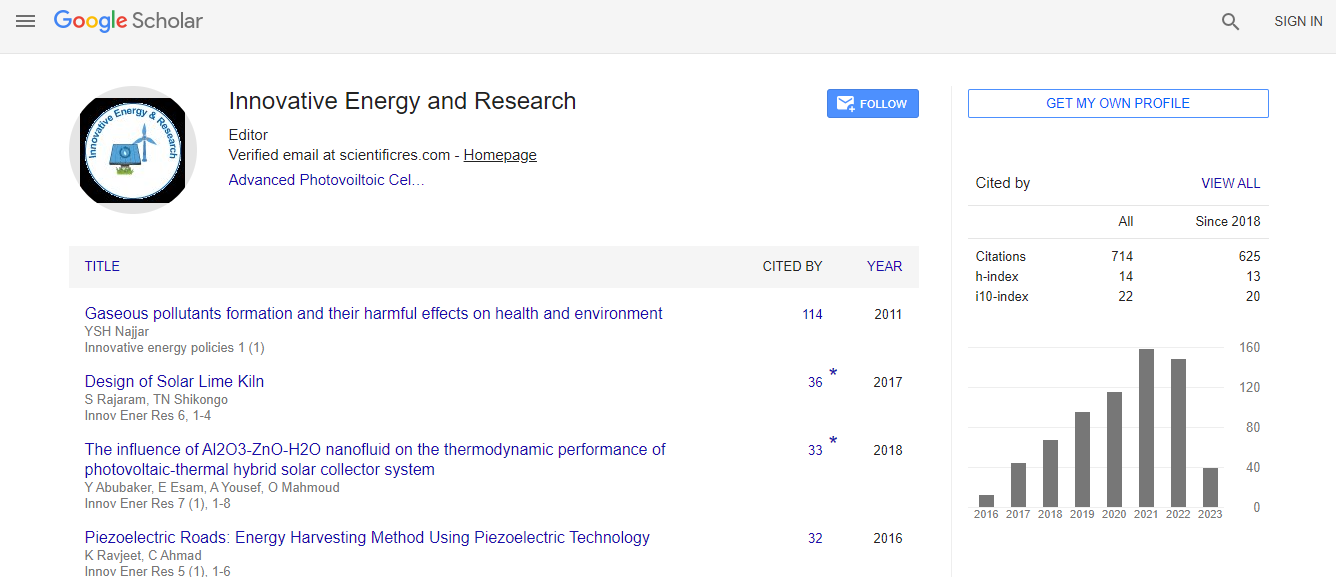Our Group organises 3000+ Global Conferenceseries Events every year across USA, Europe & Asia with support from 1000 more scientific Societies and Publishes 700+ Open Access Journals which contains over 50000 eminent personalities, reputed scientists as editorial board members.
Open Access Journals gaining more Readers and Citations
700 Journals and 15,000,000 Readers Each Journal is getting 25,000+ Readers
Google Scholar citation report
Citations : 712
Innovative Energy & Research received 712 citations as per Google Scholar report
Innovative Energy & Research peer review process verified at publons
Indexed In
- Google Scholar
- Open J Gate
- Genamics JournalSeek
- RefSeek
- Hamdard University
- EBSCO A-Z
- Publons
- Euro Pub
- ICMJE
Useful Links
Recommended Journals
Related Subjects
Share This Page
Performance of dye sensitized solar cells (DSSCs) based on Cu-doped TiO2 nanostructures photoanodes
21st International Conference on Advanced Energy Materials and Research
Sara Chahid, Desiree M de los Santos and Rodrigo Alcantara
Universidad de Cadiz, Spain
Posters & Accepted Abstracts: Innov Ener Res
Abstract
In this research study, Cu-doped TiO2 nanostructures with different doping contents from 0 to 10.0% (mole fraction) were synthesized through hydrolysis at low temperature. The prepared Cu doped TiO2 nanostructures was characterized with several techniques, X-ray diffraction (XRD) and Raman spectroscopy were used to study the morphology and structure of the nanoparticles, which confirmed the crystalline anatase tetragonal structure. The UV-Visible Spectroscopy Analysis was found that incorporation of Cu2+ into titanium affects the band gap of TiO2 and extending his activity towards visible sunlight region. Scanning Electron Microscopic (SEM) analysis confirming the Cu content is incorporated into TiO2 lattice affecting efficiency of doped samples. Further, the active specific surface area of the system was investigated employing Brunauer-Emmett-Teller (BET) measurement. Then the dye-sensitized solar cells (DSSCs) based on Cu-doped TiO2 photoanodes were fabricated and investigated with chemically absorbed Ruthenium N3 dye electrode under light illumination with standard solar simulator (AM 1.5G, 100 mW/cm2). Results demonstrated that the 1.0% Cu-doped TiO2 sample annealed at 773 K for 60 minutes exhibited the best photovoltaic performance of open circuit voltage (Voc = 957.5 mV), short circuit current density (Jsc = 0.795 mAcm-2), and the cell efficiency was reached (η = 4.524 %), which consists 50% higher than the un-doped cell. The BET analysis was supported the founding results, indicating that the 1.0% Cu-doped TiO2 nanoparticle presented the higher active specific surface area of 143.2 m2g-1. A highest active surface area is a key parameter for solar cells effectiveness, allowing more organic dye and electrolyte to be absorbed and stored into the semiconductor that give photon from solar light energy more probability to be adsorbed which obviously led to improve global cell efficiency. This study may open up more investigated works applying Cu doped TiO2 in photovoltaic fields.Biography
E-mail: sara10chahid@gmail.com

 Spanish
Spanish  Chinese
Chinese  Russian
Russian  German
German  French
French  Japanese
Japanese  Portuguese
Portuguese  Hindi
Hindi 
